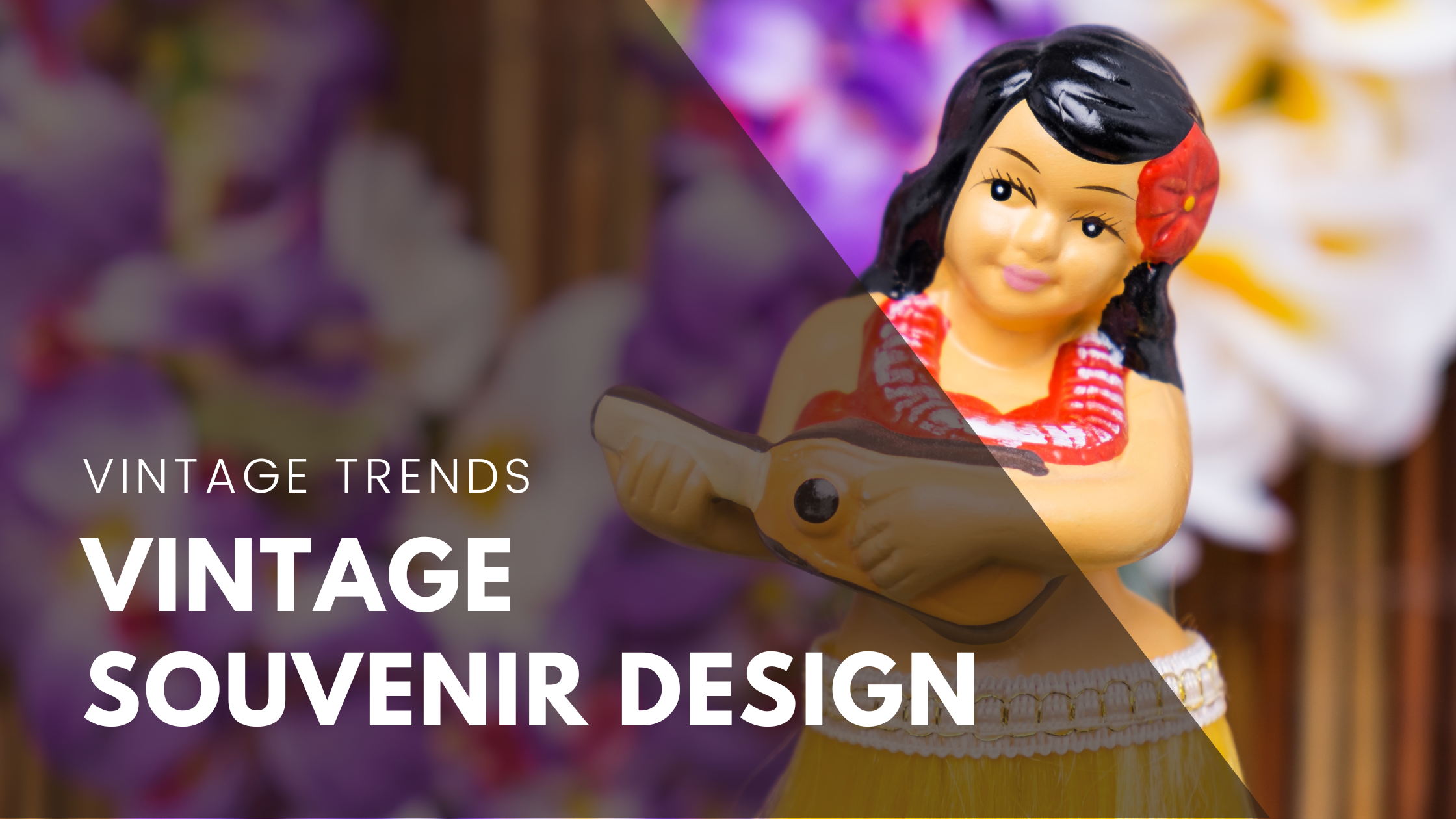The Art of Vintage Souvenir Design: From Kitsch to Classic
Traveling the world exposes us to new cultures and breathtaking landscapes and allows us to collect cherished memories and keepsakes. Among the most beloved souvenirs that have stood the test of time are vintage souvenirs, charming tokens of our journeys that hold a unique allure. These vintage mementos not only transport us back to the places we visited but also offer a glimpse into the artistic evolution of souvenir design.
So, let us embark on this enlightening voyage through time and design as we uncover vintage souvenirs' captivating artistry and enduring charm. We'll delve into the origins of kitschy souvenir designs, where bold colors, comical imagery, and quirky slogans once reigned supreme. From there, we'll discover the sentimental value that vintage souvenirs hold as they become treasured reminders of our most cherished experiences. Whether you're an avid collector or simply an admirer of timeless beauty, this exploration promises to leave you with a newfound appreciation for these artful tokens of travel and the memories they represent.
The Early Days of Kitsch
The term "kitsch" originated in art during the late 19th century and referred to artwork considered overly sentimental, mass-produced, or lacking artistic merit. In the context of souvenir design, kitsch emerged as a popular style during the early 20th century, coinciding with the rise of the tourism industry and the increasing affordability of travel.
Kitschy souvenir designs aim to capture the essence of a destination in a lighthearted and playful manner. They often featured exaggerated and stereotypical representations of local landmarks, cultural symbols, and traditions. These designs appealed to travelers because they offered a sense of fun and whimsy, making them the perfect keepsakes to remember their trips.
Typical Characteristics of Kitschy Vintage Souvenirs
Bold Colors: Kitschy vintage souvenirs are known for their vibrant and eye-catching color palettes. Bright hues such as neon pinks, oranges, and electric blues were commonly used to evoke a sense of excitement and playfulness.
Cheesy Slogans: Kitschy souvenirs often featured catchy and humorous slogans that played on local sayings or cultural references. These slogans added a touch of wit and amusement to the designs, making them memorable and endearing to travelers.
Comical Imagery: Kitsch, in souvenir design, embraced exaggerated and cartoonish depictions of landmarks, animals, and local icons. Caricatures of famous monuments or iconic structures were prevalent, adding charm and entertainment to the souvenirs.
Repetitive Patterns: Kitschy designs sometimes employ repetitive patterns or motifs to create a visually striking effect. These patterns could include repeating images of palm trees, the Eiffel Tower, or other symbols associated with the destination.
Popular Kitsch Souvenirs from The Past:
Eiffel Tower Snow Globes: Souvenir snow globes featuring the Eiffel Tower have long been a classic kitschy memento for Paris tourists. In 1889, French artisans created the first iconic snow globes for the Paris Exposition to celebrate the inauguration of the tower and the 100th anniversary of the French Revolution. It featured the Eiffel Tower surrounded by glittering snow. From this point on, the concept of snow globes as travel souvenirs gained popularity throughout Victorian Europe.
Tacky Tiki Mugs: Tiki culture in the mid-20th century inspired kitschy souvenir mugs shaped like Polynesian idols or tropical characters. Trader Vic used the first ceramic mugs at his eponymous restaurant in the 1940s. These mugs enhanced the feeling of being transported to an exotic location that Tiki bars aimed to provide. As Americans became more interested in Polynesia and Hawaii, the popularity of these mugs grew from their modest beginnings.
Travel Postcards: Kitschy postcards featuring humorous illustrations or punny slogans were popular souvenirs in the mid-20th century. These postcards showcased everything from beach scenes with cartoonish sunbathers to comical depictions of local landmarks.
Kitschy State Plates: Did you know that souvenir state plates originated in the 1870s and gained popularity among travelers with the rise of cars? While you may come across numerous flea market-style plates that are not signed, keep an eye out for those made by renowned manufacturers such as Vernon Kilns, Homer Laughlin, Salem China Company, and Wedgewood. These plates often included bright colors, cheesy slogans, and caricatures of local icons.
Hawaiian Hula Dashboard Dolls: The Hula Girl Dashboard Doll was created in 1950. The popularity of this doll skyrocketed due to the influx of American soldiers into Hawaii during World War II, along with the subsequent increase in tourism after the war. It has since become one of the most beloved souvenirs and gifts ever. The dashboard hula doll was made of plastic and had springs in her legs or stomach so that she could wiggle her hips as the car moved. She was made in different versions, colors, and sizes. The ukulele and hands-in-the-hair pose were the two most common styles. Dashboard hula dolls became iconic kitschy souvenirs from Hawaii during the mid-20th century.
Nostalgia and Sentimental Value
Nostalgia is a powerful emotional force that transports us to cherished moments from our past. Vintage souvenirs can tap into this nostalgia factor, evoking emotions and memories associated with our travels and experiences. The enduring appeal of vintage souvenirs lies in their ability to connect us with the places we've been, the people we've met, and the adventures we've had.
Vintage souvenirs often hold a distinct design aesthetic that reflects the styles and trends of their era. This design authenticity is a gateway to revisiting the time when they were acquired, immersing us in the culture and sentiment of that period. Whether it's a kitschy postcard from the '60s or an intricately crafted porcelain figurine from the early 20th century, these souvenirs serve as tangible portals to bygone times, sparking feelings of warmth and familiarity.
One of the most remarkable qualities of vintage souvenirs is their ability to encapsulate memories within physical objects. Each souvenir carries a story –a place visited, an adventure undertaken, and the emotions felt. These mementos become tangible tokens of our journey through life, reflecting the diverse tapestry of experiences that shape us.
The sentimental value of vintage souvenirs often transcends their material worth. They remind the people we shared those moments with – friends, family, and even chance encounters that turned into lifelong connections. Vintage souvenirs become bridges between generations, allowing us to share our stories with loved ones and pass our experiences to future generations. How vintage souvenirs evoke fond memories and emotional connections to specific places.
In essence, vintage souvenirs are not merely inanimate objects but vessels of our experiences and emotions. They preserve the spirit of our travels and enable us to continue our journey through time whenever we wish to embrace the past. As we hold these souvenirs, we hold the key to unlocking the treasure trove of cherished memories that enrich our lives.
Artistic Elements in Vintage Souvenir Design
Classic vintage souvenir designs showcase a level of artistry and craftsmanship that has made them enduring symbols of quality and creativity. The artistry behind traditional vintage souvenirs is evident in the choice of materials, the precision of the design, and the overall aesthetic. Whether it's a porcelain figurine, a hand-painted dish, or a beautifully sculpted miniature landmark, these souvenirs exude a sense of sophistication that elevates them beyond mere tourist trinkets.
Classic vintage souvenir designs often feature intricate illustrations and hand lettering that add depth and character to the pieces. Talented artists painstakingly created these illustrations, capturing the essence of the destination they represented. Hand lettering, instead of mass-produced fonts, gave the souvenirs a personal touch that resonated with the authenticity of the experience.
Traditional printing techniques, such as lithography, screen printing, and hand-painted details, were commonly employed to create classic vintage souvenirs. These techniques allowed for a level of customization and artistry that mass-produced items couldn't replicate. The result was a collection of keepsakes that felt unique and carefully crafted.
The Transition from Kitsch to Classic
One of the defining characteristics of the transition from kitschy to classic in souvenir design is the shift in color palettes. Kitschy vintage souvenirs often embraced bold and playful colors to create a sense of fun and excitement. These vibrant hues were eye-catching and contributed to the lighthearted appeal of kitschy designs.
In contrast, classic vintage souvenir designs took a more refined approach to color. The palettes became more muted, featuring softer and more sophisticated tones. Earthy colors, pastels, and subtle gradients were often used, creating an understated elegance that aligned with the timeless nature of these souvenirs.
This color shift reflected changing design trends and catered to a more mature and discerning audience. Classic vintage souvenirs were designed to be cherished keepsakes that could seamlessly integrate into home decor, creating a sense of nostalgia and sophistication that appealed to a broader range of collectors and enthusiasts.
The combination of artistry, intricate details, and a refined color palette in classic vintage souvenir designs elevated these pieces to the status of art. They became more than mere tokens of travel; they became expressions of culture, history, and the beauty of the places they represented. Today, these classic souvenirs continue to be admired for their craftsmanship, providing a window into the artistic sensibilities of the past.
As we celebrate the art of vintage souvenir design, let us remember that these pieces, whether kitschy or classic, are more than artifacts; they are an ode to the human desire to explore, connect, and create lasting memories. May we continue to appreciate their beauty, their history, and the emotional resonance they bring to our lives.
So, as you browse your collection of vintage souvenirs or embark on new journeys that yield more treasures, may you carry with you the appreciation for the artistry that has shaped these mementos and the nostalgia that makes them timeless. In doing so, may you find joy in the journey and a piece of the world in the palm of your hand.






